Celluloid Heroes
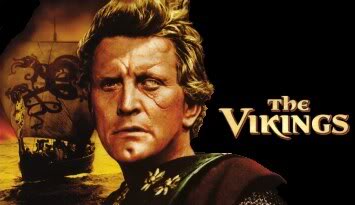 The year was 1958. I was six years-old. Life was a waking dream filled with magic, mystery, and wonder. It was a year that would have a lasting effect on me.
The year was 1958. I was six years-old. Life was a waking dream filled with magic, mystery, and wonder. It was a year that would have a lasting effect on me.
It was the year I first encountered the cinematic “ancestors” of the warriors and heroes I would go on to discover ten or so years later in the paperback pages of Lancer, Ballantine, Avon, Signet, Paperback Library, Pyramid, and other publishers who had taken up the banner of sword and sorcery, and heroic fantasy.
Of course, I had already become a fan of Disney’s Zorro, had seen the Errol Flynn swashbucklers on television, and had desperately wanted to become a pirate when I grew up. I would also see Spartacus, starring Kirk Douglas, The Mongols, starring Jack Palance, Hannibal, starring Victor Mature, and other films like Genghis Khan, The 300 Spartans, and Ben Hur a few years later. On television I would later see the silent Thief of Baghdad and Siegfried, and other adventure films of the 1930s and 40s.
But the movie theater in 1958 would have the most profound impact on my life.
The film that started it all was The Vikings, starring Kirk Douglas, Tony Curtis, Janet Leigh, and the wonderful Ernest Borgnine, whom I recently had the pleasure of meeting.
The Vikings instilled in me a love for all things Norse, just as books and other films would in time stir my passion for Greek mythology and the Roman Empire.
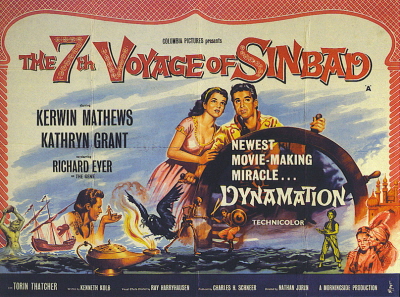 The 16 notes that begin the main theme of Mario Nascimbene’s masterful score for The Vikings (as the dragon ships sail into the fjord) still give me goose bumps. And Jack Cardiff’s exquisite cinematography really put me inside the movie when I was a kid.
The 16 notes that begin the main theme of Mario Nascimbene’s masterful score for The Vikings (as the dragon ships sail into the fjord) still give me goose bumps. And Jack Cardiff’s exquisite cinematography really put me inside the movie when I was a kid.
The film’s action-packed, emotional climax and finale still resonate and touch me deeply. Say what you will about this film, but for this six year-old boy who was also an only child, the story of two half-brothers and its sad resolution has never failed to touch my heart.
The Vikings is also one of the few times I went to the show with both my parents. Usually it was just my Dad who took me to see a movie or two every Sunday. (My Mom did drag me to see some of her “women’s pictures,” which only now I’ve come to appreciate, movies like the Douglas Sirk films. But she did take me to a triple-feature one Saturday: we saw The Day the Earth Caught Fire and Brides of Dracula, but I can’t recall the third movie because by then Mom had had enough. But I digress.)
There was another film that year that not only blew me out of my seat; it’s also credited with inspiring scores of Special FX artists.
I’m talking about Ray Harryhausen’s masterpiece, The 7th Voyage of Sinbad, of course. [Click on the poster above — or any of the images in this article — to see bigger versions.]
To see this film on the big widescreen, viewing it through six year-old eyes, is one of my most cherished cinematic memories. From the moment that big cyclops appears on screen I was transported to a whole new world.
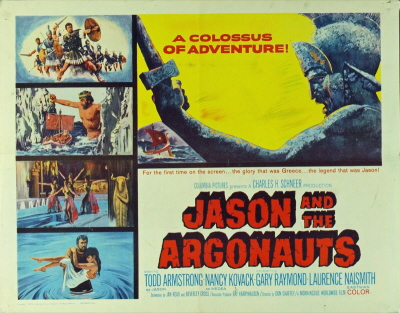 Bernard Herrman’s wonderful score set the perfect tone and heightened the magic of this all-time classic. From a handmaid turned into a snake-woman, a shrunken princess, a pair of cyclopes, and a fire-spitting dragon, to a giant Roc and her babies, a genie, magic potions, an evil sorcerer, and that most incredible sword-fighting scene between Sinbad and the skeleton — I was transfixed.
Bernard Herrman’s wonderful score set the perfect tone and heightened the magic of this all-time classic. From a handmaid turned into a snake-woman, a shrunken princess, a pair of cyclopes, and a fire-spitting dragon, to a giant Roc and her babies, a genie, magic potions, an evil sorcerer, and that most incredible sword-fighting scene between Sinbad and the skeleton — I was transfixed.
Only one other film, Harryhausen’s second masterpiece, Jason and the Argonauts inspired and moved me so deeply. Three of the six tales in my book, Mad Shadows, contain creatures I “designed” as a tribute to Ray Harryhausen.
Now we come to the start of a cycle of films that can be somewhat compared to the sword and sorcery cinematic boom of the 1980s.
Two highly-successful films started this cycle: Hercules and Hercules Unchained starring award-winning body builder, Steve Reeves.
Loosely based on the Greek myth of Heracles, these films had it all: magic and monsters, beautiful women and nasty villains, plenty of action, and a stalwart hero who barely cracks a smile.
While Reeves had the physique, the good looks, and the screen presence of a movie star, he wasn’t much of an actor, and he never really got the chance to grow as an actor. But he was nonetheless a huge success, and I’ll always be a big fan of his films.
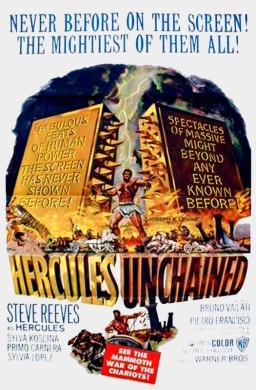 Like so many that were to follow, these films were made in Italy and Spain, and were dubbed very poorly — often with hilarious results—into English.
Like so many that were to follow, these films were made in Italy and Spain, and were dubbed very poorly — often with hilarious results—into English.
I even think Reeves, who was from California, had his voice dubbed too, because he doesn’t sound the same in many of his other films, like Goliath and The Barbarians, The White Warrior, and the hard-to-find pirate classic, Morgan the Pirate.
The success of Hercules and Hercules Unchained launched the Sword and Sandal (or Swords and Togas) craze of the early 1960s — what the Italians called peplum (the plural being pepla.) Athletes, stuntmen and bodybuilders named Dan Vadis, Ed Fury, and Samson Burke were often the stars.
Pepla films were the precursors of the Spaghetti Western boom that followed in the late 1960s. These films all had a pseudo-mythic, epic scope with stories featuring elements of the fantastic and supernatural.
Some were based on history, like Cleopatra’s Daughter, Spartacus and the Ten Gladiators, Caesar the Conqueror, starring Cameron Mitchell, Colossus and the Headhunters, starring Rod (The Time Machine) Taylor, and Romulus and the Sabines, starring Roger Moore.
Most were very loosely drawn from myth and legends: Ali Baba and the Seven Saracens, Samson and the Seven Miracles of the World, Atlas in the Land of the Cyclops, and Hercules and the Princess of Troy.
An early version of Jason’s quest for the Golden Fleece, The Giants of Thessaly, was at the opposite end of the spectrum compared to Ray Harryhausen’s wonderful and visionary epic, Jason and The Argonauts. There were even some attempts at heroic mash-ups, like Thor and the Amazon Women, Maciste in King Solomon’s Mines, and Ulysses against the Son of Hercules.
Speaking of the Son of Hercules . . . there were quite a few films featuring one or another “sons of Hercules.” These films are a riot to watch — great late-night fun (they also boasted a decent rock and roll title song.)
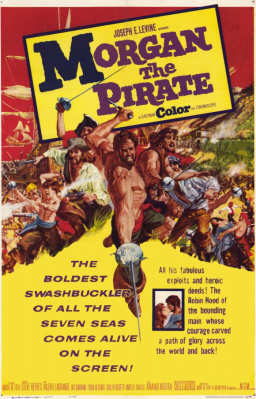 Other stuntmen and bodybuilders starred in these films: Reg Park, Alan Steel, Gordon (Tarzan) Scott, and Mark Forest, who holds the record for appearing in more of these films than any other actor. Even Peter Lupus, from the original Mission: Impossible television series starred in one of these pepla magnum opuses.
Other stuntmen and bodybuilders starred in these films: Reg Park, Alan Steel, Gordon (Tarzan) Scott, and Mark Forest, who holds the record for appearing in more of these films than any other actor. Even Peter Lupus, from the original Mission: Impossible television series starred in one of these pepla magnum opuses.
Each of these Mostaccioli Epics, as I call them, boasted special FX right out of Joe’s Garage and Basement, performances as wooden as Pinocchio’s nose, and storylines that were often illogical or plain hard-to-follow, and hurriedly dubbed by unconvincing voice actors.
But they also presented a bevy of gorgeous women and enough action to keep any fan of professional wrestling satisfied.
But honestly, most of these films were far worse than so many of the B- and C-films later produced during the sword and sorcery craze of the 1980s. By comparison, many Mostaccioli Epics made Ed Wood’s or Ray Dennis Steckler’s celluloid adventures look like John Ford masterpieces.
Occasionally you’d find a gem, like Damon and Pythias, starring Guy (Zorro, Lost in Space, Captain Sinbad) Williams, Goliath and the Dragon, starring Mark Forest, and Duel of the Champions, starring Alan (Shane) Ladd.
The Giant of Marathon, starring Steve Reeves, was directed by Jacques Tourneur (who directed many great films for Val Lewton), and had great cinematography by Mario Bava.
But mostly what we were seeing on our movie and television screens were cinematic quickies more often than not produced on a minuscule budget and directed by beginners still learning their craft.
I saw just about every one of the pepla films on television when I was a kid, on local stations at 10:30 PM every Saturday night. These were very guilty pleasures.
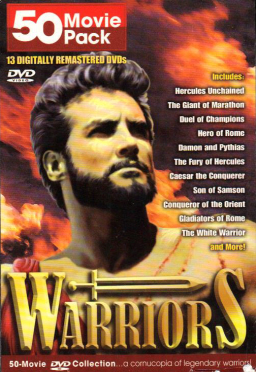 While they seemed to have been earnestly made, the vast majority of them were really quite laughable — especially when viewed today.
While they seemed to have been earnestly made, the vast majority of them were really quite laughable — especially when viewed today.
I mean . . . Hercules and the Masked Rider, set in medieval Spain?
Watching some of these films today can be a little painful, even for me, though they do press my nostalgia button. Very, very few had the production values and skill that went into the making of better and earlier films like Hercules, Spartacus, Ulysses (with Kirk Douglas), the Ray Harryhausen epics, and the biblical extravaganzas of Cecil B. deMille, such as Samson and Delilah.
I always hoped RH would make a film about Hercules, and I’ve been told that he was very interested in doing a version based on the legendary Twelve Labors of Zeus’s favorite son.
All the pepla films I’ve mentioned, except for the original Hercules can be found on Warriors: 50 Movie Pack, from Mill Creek Entertainment (2006), a collection of 13 CDs.
But beware — the box “claims” they have been Digitally Remastered, but I highly doubt it.
They look as if they were dubbed from very poor VHS versions — some of which might even have been videotaped right off the television!
And not one of these films is in widescreen format, which is painfully evident when you watch them. Some of them look even worse than I remember from watching them on a small, black and white television with a weak antenna and a lousy signal.
Fuzzy and blurry best describe the look of these CDs.
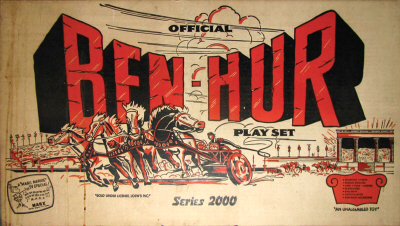 These films bear kinship to sword and sorcery, with heroes and warriors (and maybe even an actor or two) that could have very well been named Conan.
These films bear kinship to sword and sorcery, with heroes and warriors (and maybe even an actor or two) that could have very well been named Conan.
Indeed, the Cimmerian can trace his cinematic ancestry, as well as his literary heritage, to Hercules, Samson, Gilgamesh, Siegfried, Roland, and El Cid.
After all, Conan was born out of the mists of myth and legend, as was so much sword and sorcery, and heroic fantasy.
But I loved these films when I was a kid. My friends and I would play Hercules and Samson in our backyards and alleys.
I even used the plots and stories of the films and myths when I played with my “Ben Hur” playset by Marx Toys, and the hundreds of miniature Roman soldiers you could purchase at the drug store or Woolworth’s — about a buck for a bag of 25 or 50 soldiers, if memory serves me.
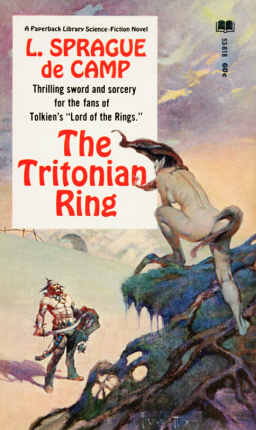 That’s why I purchased the 50-movie Warriors Collection (at only $25.00) — to relive those wonderful days of yesteryear when summer seemed to last all year and the sun never ceased to shine.
That’s why I purchased the 50-movie Warriors Collection (at only $25.00) — to relive those wonderful days of yesteryear when summer seemed to last all year and the sun never ceased to shine.
While I don’t recommend this Warriors Collection to everyone, it might be something film buffs and younger readers out there might be curious to look into.
Pepla films can be great fun to watch with a group of friends — making up your own dialogue and shouting out comments.
But these sword and sandal epics won my heart when I was a kid. That’s why The Hobbit, The Lord of the Rings, The Tritonian Ring, The Swords of Lankhmar, and then Conan, Robert E. Howard, and the whole sword and sorcery genre took hold of me and transported me to exotic realms, lost worlds, and other times.
I find it quite interesting that the Conan and sword and sorcery boom of the later 1960s followed so closely on the heels of the pepla craze. Had these movies primed the pumps of so many of our imaginations?
Wikipedia is a fount of information on sword and sandal, and pepla films.
Type in the names of the films and actors I’ve mentioned and you can learn even more about this curious craze and innocent phase of adventure films.
Thanks, everyone. Hope you enjoyed this!
If you want something visual,
that’s not too abysmal,
we could take in an old Steve Reeves movie…
@@ Lugo — thanks! I wish theaters would play some of these old films.
@@@ John O’Neil — thank you for another beautiful presentation. FYI — I saw the box for the ben Hur play set. If anyone out there is interested, here are two websites devoted to the glorious playsets of the 1950s and 1960s:
http://www.classictoysoldiers.com
http://www.conteco.com
They don’t make ’em like that anymore. Well, yeah — I guess they do, lol!!!
Have you seen The Long Ships from 1964? If not, I think it’d be right up your alley. I have vague recollections of seeing it on TV back in the 1980’s but I never actually knew what movie the scenes I remembered were from until recently when I got a copy from Netflix.
@@ Joe H — hello! Yes, I’ve seen The Long Ships a number of times. Lionel Jeffries steals the whole film. I enjoyed, but I was actually in my late 20s when I first saw it on TV — somehow my Dad missed that one at the theaters. I didn’t include it because it wasn’t part of my childhood. Still, thanks for mentioning it. A good film.
Never saw any Pepla back in the day — none of the local TV stations were airing them, unfortunately. I should do something about that one of these days.
We had a summer kiddie matinee series at the local theater, though, and for me, at least, the highlights were the weeks they’d show the Harryhausen movies. It still doesn’t get any better than that.
No, it doesn’t get any better than that. Wish they’d show some Harryhausen around Chicago.
Thanks for the memories, Joe. You and I were most likely watching these movies on TV at the same time, you in Chicago and me in a little town near Philadelphia. I’d have to say that these movies were part of Imaro’s foundation, long before I ever wrote about him. There was one where the hero went into an underground world inhabited by people who were not vampires, but died if they were exposed to sunlight. The hero had a black companion who was almost his physical match. Do you remember this one at all? I can’t think of its title. I know it was in the “Sons of Hercules” series.
Hi, Charles! Yeah, I know the film, but heck if i can remember which one of “the mighty sons of Hercules. . . ” this was. That guy got around and had more kids than Mickey Rooney had wives! Could be “Mole Men against the Son of Hercules.” That would be Maciste, this time, played by Mark Forest. The underground dwellers were albinos. That was the first SOH film I ever saw. These films, as bad as they were, primed us for the invasion of swords and sorcery that was soon to follow.
Hey there Charles, I think Joe is right and you’re remembering Paul Wynter in Mole Men Against the Son of Hercules. As I recall though, his character starts the film acting pretty timid before busting out all heroic by the close.
This might refresh your memory…
http://www.youtube.com/watch?v=7pE8C05VvN8
Thanks, John! I was going to Wiki the film, to get the actor’s name.
Hi Joe,
I saw a lot of those movies with the guy I would eventually marry. It was around the early 60s. One of the local drive-in theaters re-ran them regularly. A bunch of us would go, sit on the back of cars or trucks. We drank soda and ate popcorn or corn nuts. If we could get it, we’d have beer. We had a great time watching them. I never heard the name “pepla.” I called them “spear in the eye” movies because seemed to me that incident invariably happened in each of them. Those and westerns were the only kind of movies that got the guys out of the back seat of the cars.
Fun memories!
BB
Hi, Barbara! Thank you for sharing your memories. Seems like so many of us share the same experiences. I’m glad this is striking a chord with so many people. “Spear in the eye,” huh? That’s very appropriate. I first heard them referred to as “sword and sandal,” and then a novelist told me they were called “pepla/peplum” — sword and toga. I started calling them Mostacchioli Epics after the Clint Eastwood films were dubbed “Spaghetti Westerns.” I can’t believe the special FX in these films — they were hokey when I was a kid! 🙂
The hokieness was the source of the most fun. I especially related to your statement: “*Pepla* films can be great fun to watch with a group of friends — making up your own dialogue and shouting out comments.” Going to see these in convertibles and trucks was such a trip. The worse the movie was, the more fun we had and the harder we laughed. Predictably, the girls screamed whenever the scenes became gory but the guys ate it up. Beautiful women for the guys and sexy hunks for the girls. Hokieness had a lot going for it. These movies were much like the bad horror films of that period which were also enjoyable.
Thanks for this post, Joe. It was one of those meant for sharing memories.
BB
Thank you again, Barbara! I hope my memory can remember more memories that I can share with everyone!
Ah, the Sons of Hercules! The only thing about those films I remember with any clarity is that theme song, but I spent many hours of my childhood watching them.
Hi, Sarah! For some strange reason — maybe all to due with leading me to this place in my life — I remembered many of those films. Yeah — and that song: very 1960s, almost surf-guitar. Now I’m curious to know if that song was for American audiences, or if it was used on all worldwide prints. Glad you enjoyed the article!
What a great article, Joe. Like you, I grew up watching these movies on TV (and some Saturday matinees at the theatre). I fondly remember the SoH films. The local ABC channel south of the border in Buffalo ran a slew of them in the early 60s. Hmm. That 50 movie pack sounds tempting…
Hi, Bruce! Thanks! The sad part of this 50-pack isn’t that many of these movies are just not that good, it’s that they were never really “digitally remastered.” You can tell. And not one of them is in widescreen. Timing, lack of money or what, I don’t know. Still, they’re fun to revisit on a late Friday or Saturday night.